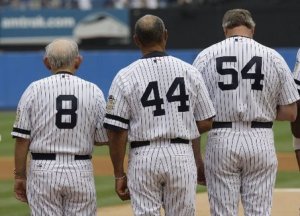
Last year, I did a piece on the Expansion Era Veteran’s Committee and the various players considered for the Hall. None of them got picked; I personally advocated strongly for Gil Hodges and Dick Allen, a little less vociferously for Tony Oliva. But, one guy I blew off as “probably not being good enough for the Hall of Fame” was Luis Tiant.
My argument against Tiant being in the Hall of Fame is he only really had six very good years. He won 20 games four times, but he only ever won more than 12 games in season seven times. Basically, his career breaks down to seven, maybe eight good seasons, six mediocre seasons and frankly, five kind of lousy seasons. I figured that isn’t good enough for the Hall of Fame. Well, the veterans’ committee agreed and didn’t put Tiant in. In fact, they didn’t put anyone in.

But, now I’ve done a bit of a 180° on Tiant now, mostly thanks to the power of persuasion … because of someone in a baseball discussion group (I’m not 100 percent positive here, but I’m looking at you, Bill Hall) pointed out to me that Tiant’s numbers were virtually the same at Catfish Hunter’s. Hunter, of course, is in the Hall of Fame and I’m not going to argue he doesn’t belong. I looked it up and compared the statistics of Hunter and Tiant and said, “oh, my gosh, this is really remarkable.” Bill was right! Their numbers are virtually identical. And they pitched in virtually the same era in the same league (Catfish Hunter 1965-1979, Luis Tiant 1964-1982). So a direct comparison is completely fair. Check this out. This is amazing. I don’t think I’ve ever seen two players with such similar stats.

Pretty darn close, aren’t they? In fact, in most of those categories, Tiant is better. He’s a LOT better in career Wins Above Replacement, a statistic I’m not wild about, but baseball sabremetrics geeks love. In fact, Tiant is 40th all-time in career WAR for pitchers, better than a LOT of Hall of Famer pitchers. His ERA+ is a lot better than Hunter’s, too. Especially in advanced metrics, Tiant’s Hall of Fame resume is stronger than Hunter’s.

Tiant led the AL in ERA twice and shutouts three times. Hunter led the AL in wins twice, ERA once and complete games once. Hunter did have an incredible five-year stretch in which he went 111-49 and won three World Series. Tiant’s success was more spread out over the course of his career, with some poor years in-between. His best five-year run was 96-58.
Catfish Hunter did have four top 4 finishes in the Cy Young voting, while Tiant finished in the top 6 three times and never finished higher than fourth. Tiant did finish fifth once in the MVP voting; Hunter finished sixth in the MVP in his lone Cy Young season. A bit of a wash here, it boils down to 1 Cy Young vs. 0 Cy Youngs.
You could argue that Hunter had more postseason success than Tiant, but actually the difference here is not as stark as you might think. Hunter pitched on five World Series-winning teams for the A’s and Yankees and went 9-6 in the postseason, including 5-3 in the World Series. However, Tiant was no slouch in the postseason, though he didn’t have near the opportunities Hunter had. Tiant went 3-0 in the postseason, including 2-0 in Boston’s legendary 7-game World Series loss in 1975. You can’t really punish him for that.
So, to be fair and honest, there is one big and very legitimate mitigating difference in the careers of Tiant and Hunter, and probably the biggest reason why one is in the Hall of Fame and the other is on the outside looking in. There is a certain element of tragedy to Hunter’s career which probably helped his Hall of Fame case, much like Kirby Puckett. Because if not for serious illness, Hunter could have — and likely would of — won 300 games in his career. Hunter’s career was tragically cut short in large part by diabetes (and possibly by his ALS which wasn’t diagnosed until 19 years after he retired, but may have been affecting him toward the end of his career, even he had no idea.). Hunter was forced to retire at 33 because of arm problems likely partly if not wholly caused by illness(es). By contrast, Tiant was able to pitch until he was 41 and was still pitching 200 innings a year at 37 and 38. So, Tiant had the advantage of a longer, healthier career to build up virtually identical numbers to Hunter’s.
So, having looked deeper into this thanks to Bill (I think), I would now argue that since Hunter is in the Hall of Fame, shouldn’t Tiant be, too … with the same or even better numbers, compiled during the same era in the same league? (And I also looked up Jim Bunning’s numbers … other than strikeouts, most of Tiant’s numbers are better than Bunning’s and their careers overlapped by eight seasons). I now think Tiant is another one of several players — Hodges, Allen, Oliva, Dave Parket, etc., who have been seriously overlooked by the baseball Hall of Fame.







